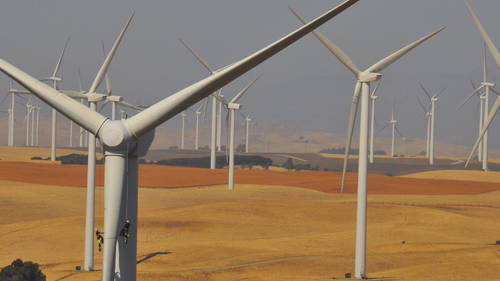From the Pacific Coast to the Texas panhandle to the Atlantic Ocean, wind power is on the rise in the United States, producing an increasing share of our electricity with minimal impact on the environment.
Just a decade ago, wind energy was a trivial part of the nation’s electricity picture. Today, wind energy is the fastest growing form of electricity generation and an increasingly important part of the nation’s energy mix. Last year, wind generated as much electricity as is used each year in the state of Georgia.
The boom in wind power is no accident, however. State and federal lawmakers have implemented far-sighted public policies, such as the federal production tax credit and our state’s renewable electricity standard, that have created the conditions under which wind energy can thrive. By unleashing the energies of innovative companies and American workers, and tapping the natural power of the wind, these public policies are moving the nation toward a clean energy future and delivering growing benefits for our environment, our health and our economy.
With the production tax credit in place, the generation and use of wind power has dramatically increased, reducing our reliance on fossil fuels, driving innovation and economic development, lowering costs and providing important environmental benefits – including carbon reductions and water savings.
Between 2007 and 2012, U.S. wind capacity tripled, representing an annual average investment of $18 billion. Tax credits have helped drive American manufacturing. Today, more than 550 manufacturing facilities located in 44 states produce 72 percent of the wind turbines and components installed in the United States, up from 25 percent in 2006.
Nowhere has this growth been greater than in Texas, which today leads the nation in wind energy. Wind energy has brought new jobs, new revenue for land-owners, a cleaner environment and lower electricity prices to Texas.
Working for turbine manufacturers like DeWind and Alstom, blade manufacturer Molded Fiber Glass, several tower manufacturers, numerous component suppliers and truck drivers and port workers delivering equipment through the Port of Houston, today more than 10,000 Texans work for the wind industry.
Texas’ wind boom has coincided with a 26 percent decline in electricity prices over the past four years. A 2012 report by the Brattle Group found that wind energy had reduced wholesale power prices in west Texas.
Wind energy is also helping clean up our air in Texas. In 2012, wind in Texas averted more than 18,000 tons of smog-forming nitrogen oxides, 22,000 tons of sulfur dioxide and 19 million tons of carbon dioxide from the state’s power sector, helping Texans breathe easier.
Amid a record drought, wind energy is also helping conserve water. Fossil fueled power plants use a huge amount of water for cooling, reducing the amount of water available for irrigation, wildlife, recreation or domestic use. In fact, more water is withdrawn from U.S. lakes, rivers, streams and aquifers for the purpose of cooling power plants than for any other purpose. But wind uses no water at all and last year, Texas wind saved 8.6 billion gallons of water – enough to fill Reliant Stadium more than 12 1/2 times.
Wind energy has also helped out in a crisis. In 2011, when cold temperatures forced the shutdown of numerous fossil fuel-fired power plants, Texas’ wind turbines continued to generate electricity, helping keep the lights on.
The benefits from investing in wind energy are endless for a state with as much natural wind resource as we have. It’s a smart investment and if we are to continue to reap the benefits, Congress needs to renew the tax credits that make it possible.
Rachel Stone is the Clean Energy Attorney for Environment Texas, a statewide advocate for clean air, clean water and open spaces.


